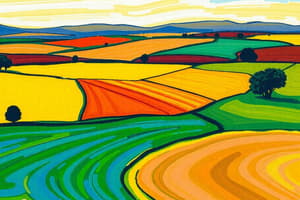Podcast
Questions and Answers
How should rural hilly land be valued according to the guidelines?
How should rural hilly land be valued according to the guidelines?
- At the same rate as irrigated land.
- At double the dry land value.
- At 75% of the dry land value based on land type and assessment. (correct)
- At 50% of the dry land value.
If a portion of hilly land is recorded as irrigated in the 7/12 extract, how is its valuation determined?
If a portion of hilly land is recorded as irrigated in the 7/12 extract, how is its valuation determined?
- It is not considered in the valuation.
- Based on the irrigated land rate, considering the land type and assessment. (correct)
- Based on the dry land rate only.
- Using a fixed rate, regardless of land type.
What percentage of the value should be considered for land under natural and public reservoirs in rural areas?
What percentage of the value should be considered for land under natural and public reservoirs in rural areas?
- 25%
- 50% (correct)
- 75%
- 100%
To what does the guideline pertaining to natural and public reservoirs NOT apply?
To what does the guideline pertaining to natural and public reservoirs NOT apply?
What valuation rate is applied to dry land purchased for agricultural use by a company?
What valuation rate is applied to dry land purchased for agricultural use by a company?
What valuation rate is applied to seasonally irrigated land purchased for agricultural use by a company?
What valuation rate is applied to seasonally irrigated land purchased for agricultural use by a company?
How is the valuation rate determined for land with year-round irrigation purchased by a company for floriculture?
How is the valuation rate determined for land with year-round irrigation purchased by a company for floriculture?
If separate rates are specified for flower gardens, orchards, and sugarcane cultivation, how is the valuation conducted?
If separate rates are specified for flower gardens, orchards, and sugarcane cultivation, how is the valuation conducted?
What is the valuation rate for land with year-round irrigation?
What is the valuation rate for land with year-round irrigation?
When evaluating land for commercial agriculture, which rate should be considered if specific rates for crops like sugarcane are available?
When evaluating land for commercial agriculture, which rate should be considered if specific rates for crops like sugarcane are available?
According to the guidelines, what factor is essential when determining the value of hilly land in rural areas?
According to the guidelines, what factor is essential when determining the value of hilly land in rural areas?
Which type of land valuation does NOT apply to the '50% of value' rule for natural and public reservoirs?
Which type of land valuation does NOT apply to the '50% of value' rule for natural and public reservoirs?
A company is purchasing dry land for commercial farming. How should the land be valued?
A company is purchasing dry land for commercial farming. How should the land be valued?
If a company buys seasonally irrigated land for farming, what valuation rate applies?
If a company buys seasonally irrigated land for farming, what valuation rate applies?
For year-round irrigated land bought by a company for floriculture, which valuation rule applies?
For year-round irrigated land bought by a company for floriculture, which valuation rule applies?
When valuing land with crops like sugarcane with distinct rates, which rate should be used?
When valuing land with crops like sugarcane with distinct rates, which rate should be used?
According to the provided guidelines, how is the value of rural hilly land determined?
According to the provided guidelines, how is the value of rural hilly land determined?
What percentage of dry land value should be considered for rural hilly land?
What percentage of dry land value should be considered for rural hilly land?
If there is both dry land and irrigated land on the same property, how is each portion valued?
If there is both dry land and irrigated land on the same property, how is each portion valued?
When a company purchases dry land for commercial farming, what multiplier is used on the standard rate?
When a company purchases dry land for commercial farming, what multiplier is used on the standard rate?
Flashcards
Valuation of Hilly Barren Land
Valuation of Hilly Barren Land
In rural areas, assess hilly barren land at 75% of the value rate for rain-fed land, based on its type and land revenue.
Valuation of Classified Hilly Land
Valuation of Classified Hilly Land
If a portion of hilly barren land is classified as rain-fed or seasonal/perennial irrigated land, evaluate that area based on its land type and land revenue rate.
Valuation of Water Bodies
Valuation of Water Bodies
Value natural and public water bodies in rural areas at 50% of the value derived using the annual value rate table and guidelines. This does not apply to farm ponds.
Valuation for Agriculture Use
Valuation for Agriculture Use
Signup and view all the flashcards
Valuation for Irrigated Land Used in Agriculture
Valuation for Irrigated Land Used in Agriculture
Signup and view all the flashcards
Rate Comparison
Rate Comparison
Signup and view all the flashcards
Study Notes
- Guidelines for evaluating hilly land: Evaluate rural hilly land at 75% of the value rate based on the type of Jirayat land and the land revenue.
- If some portion of the hilly land is Jirayat/seasonal or perennial based on 7/12 records, value that area by considering the land type and land revenue rate.
- Evaluation of land under natural and public reservoirs: Consider 50% of the value arrived at by using the annual value rate table and land guidelines for rural areas.
- These instructions do not apply to farm ponds.
- Evaluation of documents for commercial agriculture/vegetable production/floriculture/rubber plantation/teak plantation/horticulture, etc., where the company benefits:
Purchase for agricultural use:
- For rural Jirayat land, evaluate at double (200%) the rate per hectare.
- For seasonal irrigated land, evaluate at triple (300%) the rate.
- For perennial irrigated land, evaluate at four times (400%) the rate.
- For irrigated use, such as flower gardens, orchards, sugarcane farming, etc., if separate rates are given, consider those rates or the rate as per the points above, whichever is higher.
Studying That Suits You
Use AI to generate personalized quizzes and flashcards to suit your learning preferences.




